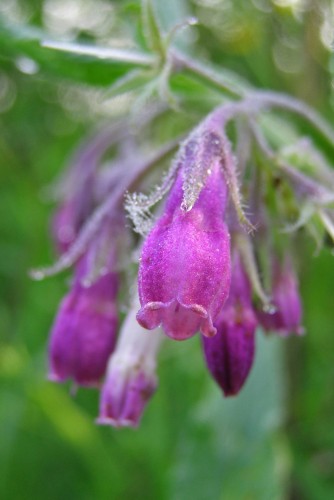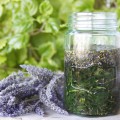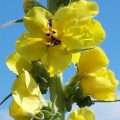- The Miraculous Shiny Bush Plant - January 18, 2021
- Colorful, Edible and Medicinal Celosia - January 10, 2021
- Radish, a Nutritional Power House - December 19, 2020
Symphytum officinale, commonly known as comfrey or bone-set, is a flowering shrub native to Asia and Europe. It is said to have been brought to North America by early European colonialists. Comfrey quickly adapted to the new environment and soon escaped to grow in the wild, where it gradually spread to the rest of the world.
[Note: The Right Flowers is not a medical site. Knowledge of and information about the therapeutic benefits and applications of flowers, while known through the ages, does not constitute medical advice. If you are having health issues, you should consult with a physician.]
The plant has a long flowering period starting from late spring to autumn. During this period, comfrey produces beautiful, multi-colored bell-like flowers ranging from yellow to fading pink. The flowers are edible and have medicinal properties too.
Initially, the plant was referred to as knitbone due to its ability to heal broken bones and knit them together almost as if they had not broken. This might also explain why the plant’s botanical name is symphytum, a Latin word, borrowed from Greek, indicating coming or growing together of bones.
The aerial parts of the plant (stems, flowers and leaves) as well as the roots are used to relief inflammation. These parts of the plant are known to contain rosmarinic and allantoin acid. Rosmarinic acid relieves pain and swelling while allantoin encourages the activity of cell proliferation or growth of new cells. This leads to the mending of broken bones and the healing of wounds. Normally, herbal preparations such as poultices and infusions contain 5-20 percent of the two acids.
Comfrey is so effective in healing bruises and cuts that some people think it is magical. Travelers report applying poultices made of the aerial parts of the plant at the site of the external injuries which had already turned blue-black and leaving it overnight. By the time they woke up in the morning, the discolored bruises had started fading from blue-black to yellow, indicating recovery. Such transformations are quite rare even with pharmaceutical products. For the topical treatment of pulled muscles, sprains, fractures and swelling, a poultice or compress soaked in the plant’s infusion is applied to the affected area.
While comfrey is a highly effective healer of minor cuts, bruises, sprains, and broken bones, it is not recommended for deep cuts. Here, the logic is that comfrey is likely to heal the outer layer of the wound faster, compared to the inner part, resulting in an abscess. However, for minor cuts, bruises, and scratches, the herb works wonders.
In the past, comfrey was used to treat internal problems such as digestive tract and respiratory system infections by Greek and European physicians. Today, it is not recommended for internal use because the plant is known to contain alkaloids which can get toxic to the liver in high doses.
While scientific studies are still ongoing to understand the full benefits of comfrey, initial tests have confirmed that this plant is as effective in treating minor cuts, sprains and joint pain just as ancient wisdom held.





